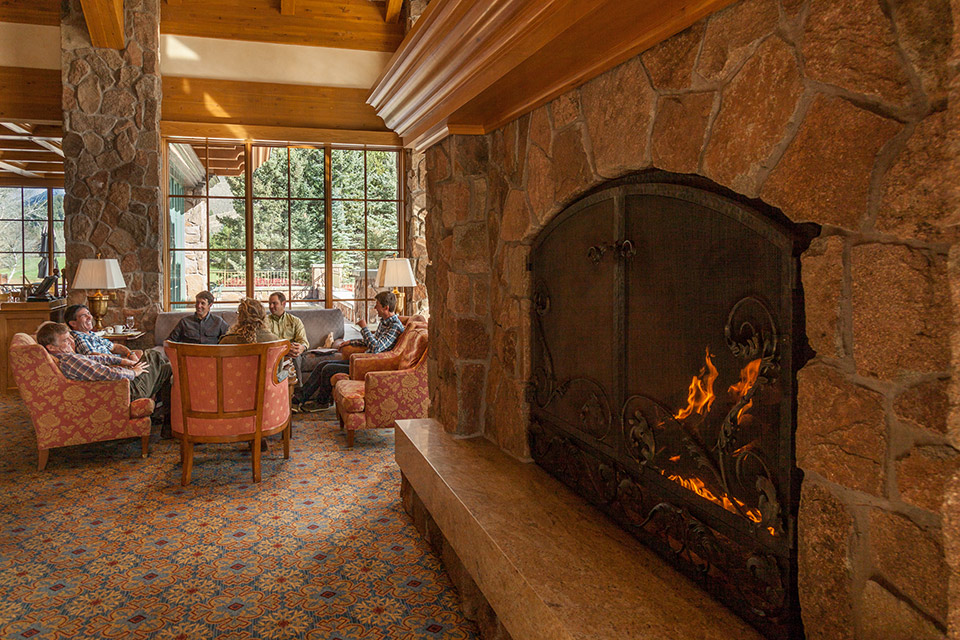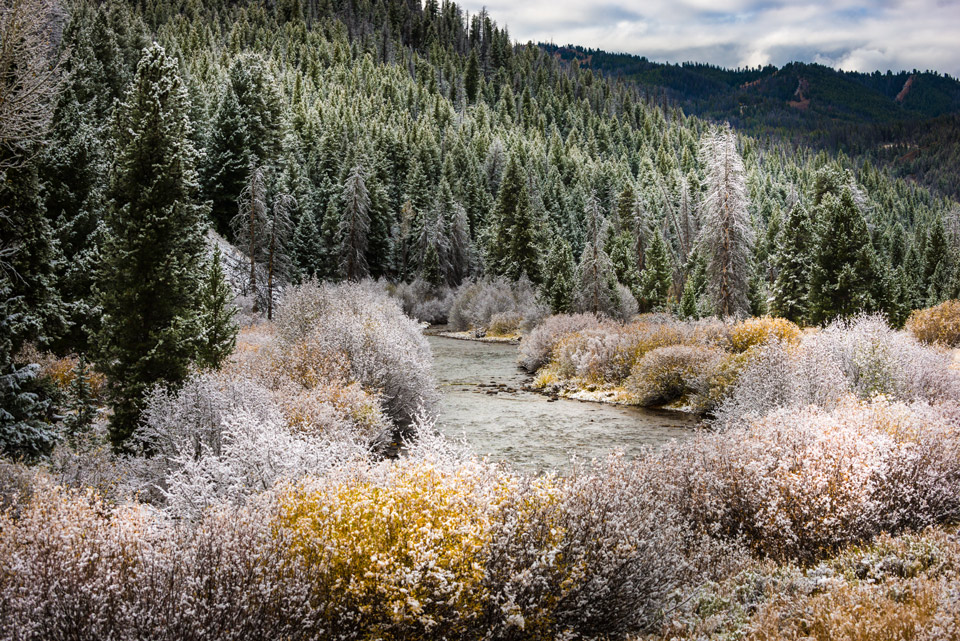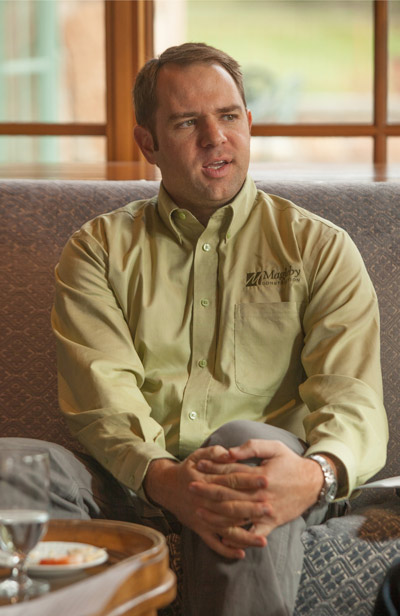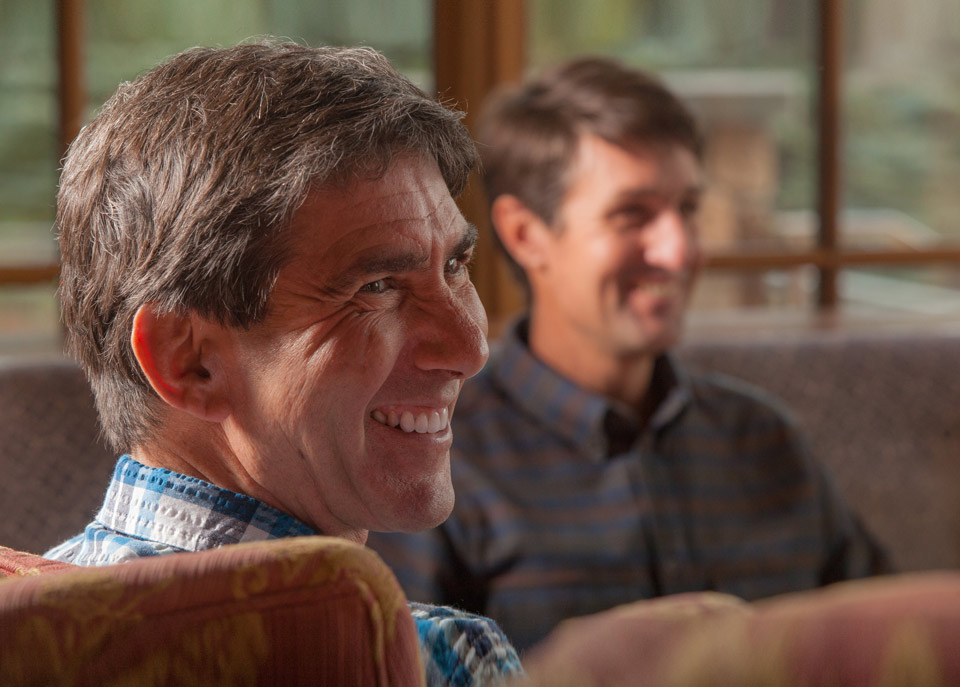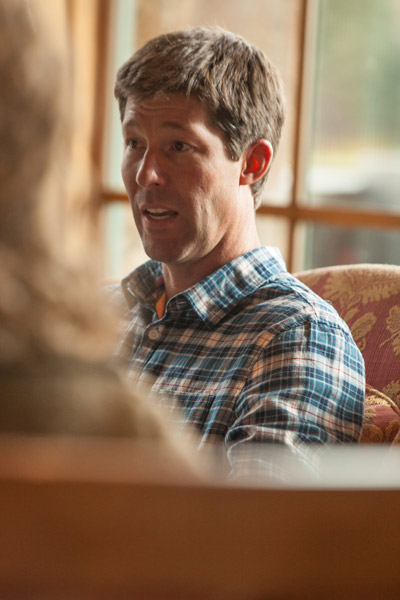The first snow fell in Ketchum on the morning of November 1, creating the perfect backdrop to gather four of the best builders in the Wood River Valley at the Sun Valley Club to talk about building trends, new products, and new projects in the area. David Lloyd of Lloyd Construction, Brian Poster of Poster Construction, Layne Thompson of Magleby Construction, and Tim Carter of Idaho Mountain Builders brought insight to the table about shifts happening in the Valley and what to look for in the coming season.
WHJ: Over the last five years, what has changed in the local building industry?
BRIAN: The level of sophistication among our clients and how that is reflected in their demands has changed; th
eir expectations related to materials and process are much more refined and accurate.
DAVID: I think we’re seeing a trend toward in-town living; clients are looking for spaces that are a bit smaller and centrally located but still offer all those creature comforts they have come to expect. We also don’t get the push back on the energy efficiencies that we used to get because people are finding value in the comfort added.
LAYNE: Among our staff, the feeling is that clients’ expectations related to timeline, process, and finish level have all advanced. I think this reflects Brian’s point about the rising level of sophistication regarding building among our clients, but also within the building community, which has been raising its professional standards. Among local builders, the sense is that the transformation of our local building community has been profound from pre-recession to today; smaller builders and long-time trade professionals have been moving on—toward retirement or new careers—and a younger trade base is emerging.
TIM: I would agree with that. I would say there are a lot of new vendors in the wake of the recession, and there are many new sources for materials. The other thing I’d note is that the local building community is not as competitive as it may have been in the past; it’s more collaborative. It’s easier to be in a room with other builders—we’re not so protective of vendors we want to use, resources that we have, or limited materials. Now we trade labor when we’re short—we’ll send some of our guys to help out on another project in a labor pinch, and that labor will be traded back to us. I think that type of collaboration reflects a different attitude within the community than was present five years ago.
“The local building community is not as competitive as it may have been in the past- it’s more collaborative.”
– Tim Carter of Idaho Mountain Builders
WHJ: How are the prices of materials today?
DAVID: Generally they have gone up some. A lot of my build partners say there are going to be an additional price increases at the beginning of the year. With energy costs being as low as they are, though, I feel good about where we are and where we are headed.
LAYNE: From a materials pricing standpoint, the prices are following with inflation. I haven’t seen any radical moves on the materials side of things. Certainly before the recession, as a result of the build out of China, concrete and steel had pricing going crazy, but I haven’t really seen that radical shift on pricing on the material side of things.
TIM: I just called a couple vendors for a client who wanted to know what we could expect regarding materials pricing for next year, and the vendors said they didn’t forecast any unexpected shifts in pricing. The lumber and sheetrock vendors both said their price hikes tend to be tied more to unexpected events—a weather event, like a hurricane, for instance, might cause the cost of sheetrock to go up as rebuilding is launched. In the same vein, a local supplier told me they had a big mill fire last year that caused the cost of plywood to go abnormally high.
BRIAN: Like Tim, I am seeing lumber prices remain relatively stable. We haven’t seen any big spikes. There are so many options, so people can generally find really good deals if they are looking to save or choose from a really great range of high-end custom products. People have a lot more choices today—it’s no longer just chocolate, vanilla, or strawberry. There are thirty-one flavors of faucets and toilets and everything else, ranging from production quality finishes that are mass produced and relatively cost-effective to high-end, top-of-the-line imports.
TIM: There are definitely a lot more suppliers and products now, when compared to pre-recession options. New vendors come on all the time.
BRIAN: It’s important to note though, that despite all the new vendors and options, inventory can be a challenge. Vendors are not stocking as many items as they used to, so it’s more important than ever to make timely selections to keep a project on time and on budget.
LAYNE: One thing I want to add, as a little tangent to the materials discussion, is that in Sun Valley, the price of building in general is still depressed compared to the other resort markets. We build in multiple resort communities, and the clients I am talking to here are looking for the $400 to $600 per square-foot build, while in other markets we’re seeing a clientele more agreeable to at least a $600 square-foot build—and higher. Sun Valley offers a little bit more reasonable cost per square foot than what we’re seeing elsewhere, which is a benefit if you’re looking to build in a mountain town.
DAVID: I think that’s a really important statement. It’s absolutely true. Sun Valley is a great deal compared to Jackson, Aspen, or Telluride. If we’re not careful, everyone is going to move here!
BRIAN: That point leads to an interesting question for us, as builders: given the potential for growth as a result of favorable building conditions, are companies happy with where they are or do they need to continue to grow? Personally, I have reached my sweet spot—I don’t want twice as many projects as I have this year.
TIM: We feel the same way; we have room for some growth, but we don’t want to grow beyond the point where we lose a close connection to our projects.
LAYNE: At Magleby, we’re not looking to grow as fast as we can either. We hit our five-year mark in a two-year timeline with our local operation. I would like to continue to be able to cater to the projects we have now and ensure their success before looking for expansion.
DAVID: I think the conversation we’re having now reflects that the Wood River Valley is unique among mountain towns where building is concerned. We have always followed a different beat because of the lower traffic numbers.
WHJ: What is the availability of skilled craftsmen in the area now, and do you feel there will be a sufficient number in the future? And, will some skills be in more demand than others?
TIM: We’re always looking for skilled tradespeople. Right now we’re perfectly staffed and we have a good team, but if there’s any kind of growth, and things get heated, it will be a challenge because there aren’t a lot of subs. It has been great to see the development of the building academy at the Wood River High School, which is teaching kids trades. The enrollment in that program continues to grow, and support within the building community has grown with it; hopefully it will matriculate new workers and help us meet some of our needs.
BRIAN: We’ve been pretty steady in the numbers on our team. I have been running with 23, give or take two or three employees, for the last seven or eight years. But we’re always looking for the right quality person. I think it’s a really exciting time for any young person to choose to enter into the building trade because the pay scale will continue to rise as they progress. As a tradesperson in this community, you can afford to live here now; it’s back to how it was in the ‘70s and ‘80s. It’s a good time for people to head in this direction.
DAVID: I’d say that among the group we have here, we all treat people well, and in doing so we don’t have a problem retaining quality employees and trade contractors. But to get a little philosophical, I am worried about the decline in the collective value we place on the blue-collar lifestyle; I think society’s view needs to change to reflect the skill and the art involved in carpentry and other trades. I’d hope that could improve so we can continue to put together a product that we want to see.
LAYNE: I think the Wood River High School construction academy is exciting, and I love what I am hearing and what I have seen out of it. The builder and contractor associations have been really invested in it because we recognize that it will be really instrumental in showing young people that this is a really fulfilling path as an employee and manager. Another aspect the community is working to address, which relates directly to the availability of skilled labor, is affordable housing. The Sun Valley Economic Development group just held a summit addressing the issue of how to improve housing to attract a stronger and more stable workforce.
DAVID: Housing is definitely an issue, but we still have great neighborhoods for people to live in if they want to work in the Valley. And we’ve been seeing the benefit of that in the return of a younger work force in recent years; it has been great to see more twenty- and thirty-year-olds on the sites. It’s fun to have them around. There was a long time where we were wondering where the next generation was—who was going to take over.
“Sun Valley offers a little bit more reasonable cost per square foot than what we’re seeing elsewhere, which is a benefit if you’re looking to build in a mountain town.”
– Layne Thompson of Magleby Construction
WHJ: It appears there is a continual shift toward contemporary and modern design. How does it change construction practices versus building in a mountain rustic style?
BRIAN: One word: Glass. We put a lot of effort into the amount of glass in our structures locally—we go corner to corner, wall to wall, and we are fighting for the most minimalistic trim possible. We’re really trying to capture the views, and floor-to-ceiling glass allows us to do that. We’re also blending the contemporary style with the more traditional mountain style, which some people call “mountain rustic.” There has definitely been some very dynamic architecture in the last few years, and the entire architectural community has stepped it up with design and features. It’s good for the customers. It’s good for the builders. It’s good for the aesthetics of the community.
DAVID: Generally, a successful build of a modern design rests on the same foundation as any other style—it’s about hiring professionals who have the experience and expertise to do the work. Sure, there are different techniques and styles, but if you hire someone who has worked through the process and knows to ask the right questions, I don’t think there’s anything that can really trip us up. There are some special considerations related to modern architecture to create a comfortable home, but there’s nothing we can’t do.
LAYNE: A lot of the materials when you’re talking about contemporary and modern—stone, steel, glass, for instance—can be cut to fit on site with a skill saw or a table saw. You need to plan ahead and work with all your different trades. Assembly comes together with clean lines and intricate details with planning. The traditional rustic approach is a little more forgiving; there are opportunities to cover up discrepancies, whereas with contemporary modern you don’t get that—it needs to be dialed-in from the structure to the finishes.
TIM: A characteristic of the modern style is the elimination of as many trim pieces as possible, eliminating door and window casing, baseboard, or shower curbs, for example. This means you need to think through to finish a lot sooner in the building process to ensure things finish out correctly.
WHJ: Are you seeing a younger client demographic?
TIM: Yes. We are doing more projects for younger families who are moving here from more populated places to raise their kids.
BRIAN: In my experience, the “younger” demo-graphic of clients is made up of people in their 40s.
LAYNE: The majority of our clients are 35 to 55. And most of our product has been “for sale” products. I think it’s a good sign that we’re seeing a lot of them coming and buying that existing product now; then, five years down the road, they’ll hire someone to build a custom home and keep the buyer market turning over and adding new customers.
DAVID: It’s hard for me to say because I don’t think personally I am getting any older, but I am starting to build for people younger than me, which is kind of exciting.
WHJ: What size homes are you building?
BRIAN: Our projects really range in size. We have one 14,000-footer at the moment, which is the biggest of my career, but we also have three 5,000- to 6,000-square-foot homes. The average for the last ten years has been 7,000 to 8,000 square feet, and that’s been relatively consistent. The big projects like the 14,000-square-foot job we’re working on now aren’t always in the pipeline—they happen every now and then. It’s not a regular job.
TIM: Most of the houses we have built are 4,000 to 6,000 square feet. We find ourselves doing a lot of remodels and additions too. I imagine there will be more of that type of work coming as the existing building stock needs updating.
LAYNE: I don’t have a huge portfolio and history here, but I am hopeful about the trend I see among clients who want to build smaller. I think the push to move toward responsible development in building will result in more green building, which is what I would hope.
DAVID: I have built everything from really big houses to small cottages. People think that we only hang our hats on those bigger builds, but living here there are a lot of other builds that can inspire you as a contractor. We get just as much enjoyment from building a 500-square-foot cottage as we do from big projects. It’s all fun for us—from siding to window installs to a kitchen remodel. This isn’t a profession that you dip your toe to halfway—it’s all fun work. And a lot of our passion is generated by the personalities of our clients and the connection we form from the first interview. There’s a great pool of capable contractors in this valley, and we can all be proud of that. Our clients benefit from our tight-knit build community and our ability to collaborate together. It’s a giant value for our clients that we can call on one another for partnerships.
WHJ: Are financing and lending affecting how you build?
DAVID: Most of our clients don’t use banks, but for those that do, this market is not ego-driven and people do not extend themselves like they do in other markets. So I have not seen financing and lending issues affecting our projects.
LAYNE: Definitely not. The clientele here doesn’t seem to be affected by financing or lending issues. That said, I do think the building community is affected by one aspect of financing—in the speculative projects. There are a lot of projects out there that are great ideas and great pieces of land, but they just lack the financing because they are speculative.
TIM: We have a project right now that’s tied to a bank loan and it’s taking a long time to get through the process.
BRIAN: I don’t think that our answers to this question should be interpreted as a statement that decisions are not price-driven—because they are. It doesn’t matter who we work for or what level we’re building at because economic and fiscal responsibility is always part of the game. Decisions are always price-driven; people want to know accurate costs and clients determine the value of a project. If it’s valuable to them, then they’ll buy it. If it’s not a priority, then they’ll put it off and do something else. Our clients are our employers, and we get the very best information for our employers to help inform their decisions. Every decision is based on the economics of that decision.
“Our clients are our employers, and we get the very best information for our employers to help inform their decisions.”
– Brian Poster of Poster Construction
WHJ: If a client comes up with a little extra room in their budget, what products or features do you suggest adding?
Brian: It’s always important to blend the indoor and the outdoor experience as much as possible but also try to do something fun that reflects the personality of the client. As we get to know a client, we want make the house emulate their experiences and background. Early on in my career we were doing a house for a married couple, both firefighters, and we installed a fireman’s pole for the house. And that was pretty fun. We like to do things that fit the clients’ personalities.
Tim: Interior plaster is a nice upgrade. It has a beautiful crafted look and mass that really changes the way a space feels.
David: I like to make sure that landscaping and the exterior hardscape of the building are tied to the house. It’s a really important component to a successful build that has historically been overlooked, and a lot of people are trying to push for it now. I think it makes all the difference.
Layne: Hopefully, we’re looking at things that improve energy efficiency and the long-term maintenance of the building. I love building projects that are going to be maintenance-free as much as possible, whether it’s the exterior cladding, where they’re not going to have to come back every few years and refinish it, or other building assemblies. We try to ask ourselves: Can we be building in a way that preserves the home, so a maintenance budget for the long term is minimized? The answer to this would generally include improving or minimizing the consumption of energy for operating the building through innovative systems and assemblies, which can add value.
“My friends don’t ask what I do on a daily basis, but it’s funny to me because I think what I do is pretty rad.”
– David Lloyd of Lloyd Construction
WHJ: Why should someone want to do your job? What do you enjoy about it?
BRIAN: We build the coolest stuff in the country, and everyone’s goal is to build the best house we can for the client. Everyone is always aiming to do their best work. It’s easy to go to work every day when everyone shares the same goal, building the best home for someone.
TIM: We have an opportunity to work on complex projects that bring us into contact with many people and organizations within our community: town officials, building inspectors, contractors, tradespeople, and local businesses. And we get to work for clients with different stories from all over the country. It’s rewarding to come together with all these partners to figure out a project.
DAVID: I talk a lot about community, and I really value our relationships with so many different members of our community, from suppliers to lenders to tradespeople—and the daily interactions we have with all of these people. Our projects put us in touch with people and organizations across the socio-economic landscape of the Valley. It’s a sleeper profession—my friends don’t ask what I do on a daily basis, but it’s funny to me because I think what I do is pretty rad.
LAYNE: On top of the people we work with and for, what greater process exists than the creation of the built environment that people will occupy? I think we overlook that we’re hopefully changing the landscape for the better and for the benefit of future generations. Passion is a message that can be under-told in our profession, and it’s something that I want clients to know. Conveying our passion early on in a project can result in a higher level of trust between us as builders and our clients, which can be leveraged from the outset to create a better product.
WHJ: What new materials are you using?
BRIAN: We have a set of plans that will use charred Japanese siding panels called Shou Sugi Ban, which provide a way cool exterior finish—the wood is actually flamed with a flamethrower and charcoal and then sealed. Another new material I’m interested in is Thermory, for decking. Wood decking has always been a problem up here—redwood is soft and turns grey—so this provides a good alternative option.
TIM: A few innovative materials that are making a difference for us include cleaner spray-foam insulation, shingle options to replace cedar shakes, tile underlayments to better accept electric radiant heat, insulated plywood as an option to meet the new building envelope code, more efficient boilers, and PV solar panels.
DAVID: I am excited about LED lighting. It used to be that the light LED lights emitted was horrible, but now we’re getting somewhere, and it works. I have switched out thousands of bulbs in the last two years—there has definitely been a paradigm shift in this area.
LAYNE: Fused bamboo decking products have been a new material of choice. The product is compressed and fused to perform better. In addition, I try to encourage clients to consider apps and remote controls for functions in the house instead of an integrated system for thermostats, security, and lighting. App-based functionality is user-friendly and eliminates the need of tech assistance for the fully integrated system. Rather than have a client spend $100K on an integrated system, I steer them in a different direction.
WHJ: What do you see in the future for the building industry?
DAVID: I still see quite bit of room for 3D modeling. We’re doing really well disseminating information about the physical built structure, but we can make great strides in the flow of communication between engineers and architects throughout the project. I am also excited to see where we go architecturally after mountain modern.
BRIAN: As an administrator and also as the parent of a son who just graduated with a construction management degree, the software available for administration and management capacity is amazing now. I am sitting in my office with my colored pencils coloring all over the sheets, and the kids are like, “What are you doing?” They don’t even print up plans—everyone is walking around with their iPads. They’re not printing 200-page plans.
LAYNE: I see the use of more prefabricated systems in the future—things that leverage the use of labor out of the Valley to speed construction along and minimize impact on the local labor force.
TIM: I hope we see more housing built in Ketchum. We haven’t built any housing for Ketchum workers and full-time residents since the recession.
